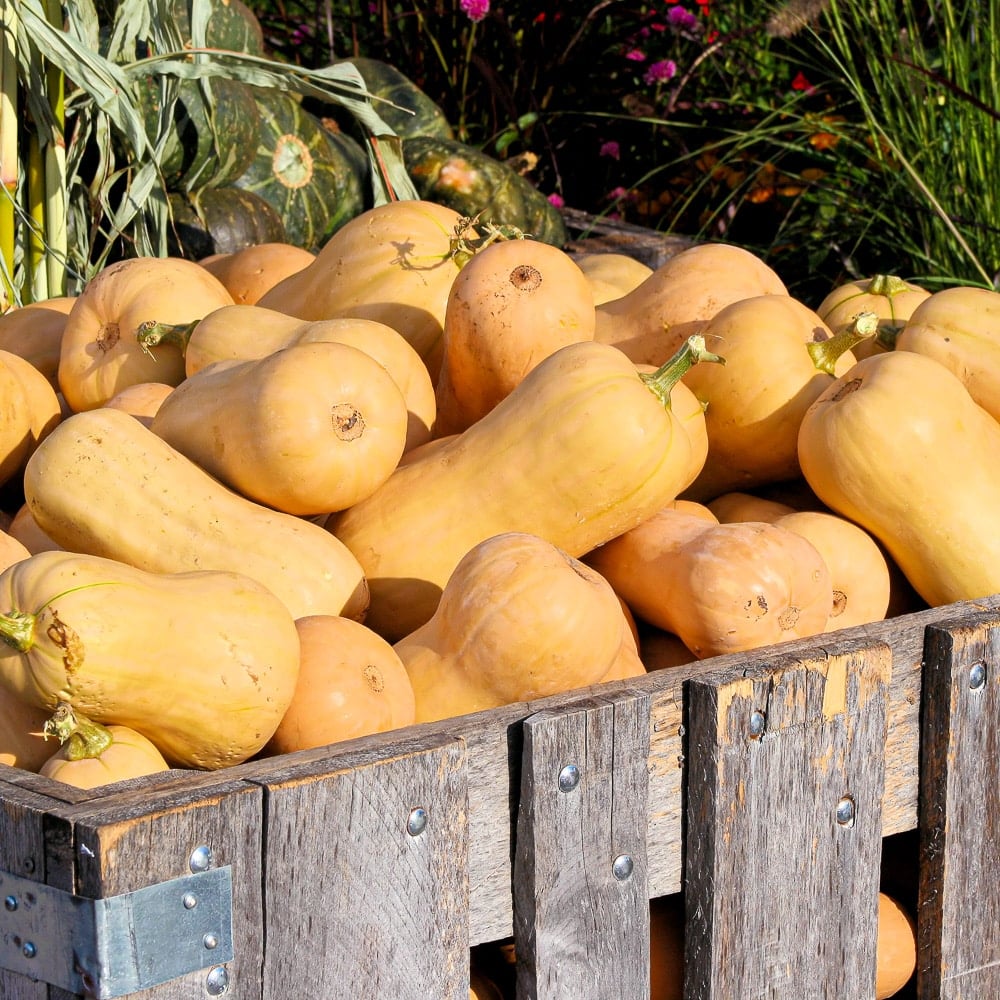Growing Cucumbers: How and When To Pick Cucumbers (2023)
Want to learn how to grow and harvest cucumbers? If you wish to make fresh cucumber salad or pickles, knowing how and when to pick cucumbers from your garden is vital – here’s everything you need to know!
Cucumbers are one of the easiest-to-grow vegetables. Give them sun, water, and support, and they will do the rest to fill your harvest basket with fresh, tasty veggies. You may just be planning your garden or planting seeds now, but it’ll be time to pick those ripe cucumbers to use in salads or make pickles before you know it.
Here is what you need to know about growing cucumbers to get them in their prime. Eating fresh vegetables from your garden is incredibly rewarding – Read on to learn how!

Two Types of Cucumber Plants
First, there are two different kinds of cucumber plants that you can grow in your gardens: bush cucumbers and vining cucumbers. They grow differently.
Bush Cucumbers
These plants are more bush-like, stay in one place, and are perfect for small gardens or growing in containers.
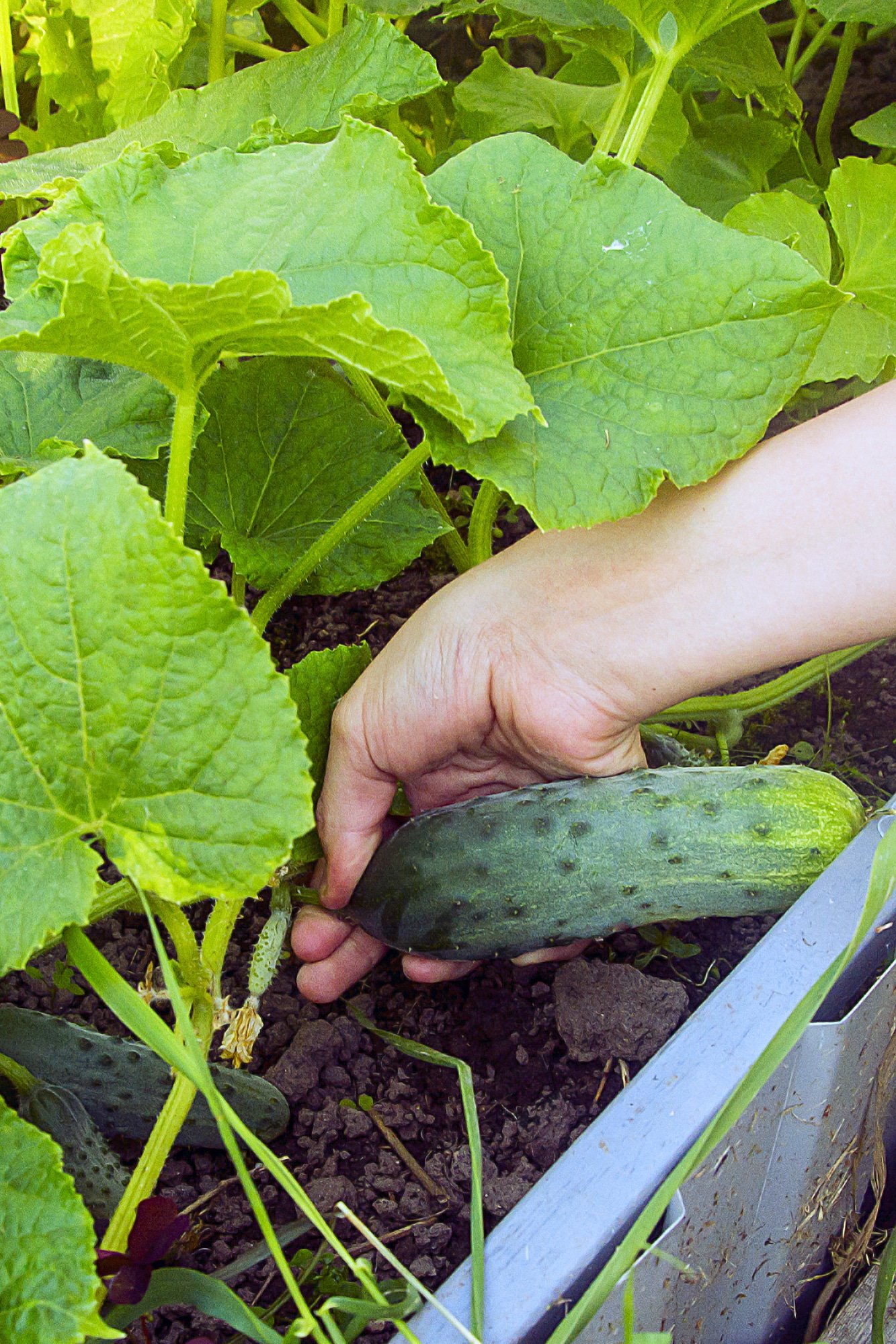
Vining Cucumbers
Vining varieties of cucumbers thrive and yield large numbers of crops. While they can grow along the ground, they do best when supported and trained to grow up a trellis.
- Learn More: See our full article about vertical gardening to learn the best types of trellises and support systems for your cucumber plants.
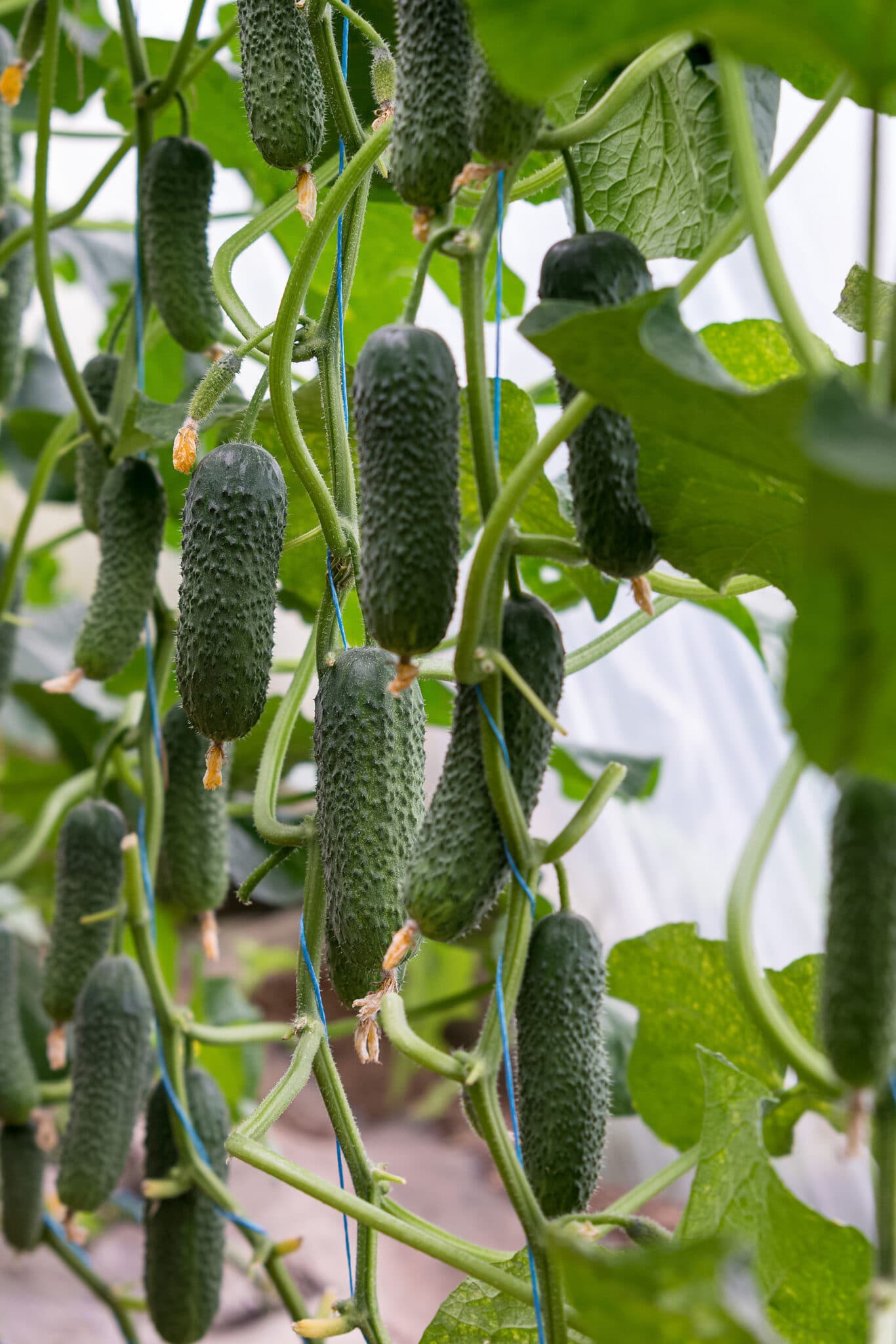
Cucumber Varieties for Different Purposes
In addition to the differences in cucumber plants, you’ll notice that cucumbers themselves are either small and bumpy or large and smooth.
Pickling Cucumbers
The small, bumpy varieties make the best pickling cucumbers. Pickling varieties usually grow to about 3-4 inches in length. Ripe fruits that are shorter than 3 inches are still good for pickling, but any that are 5 inches or longer will be too large for pickling. Harvest these ones for fresh eating. They aren’t as good as slicing varieties, but they still go great in a salad!
Slicing Cucumbers
Slicing cucumbers are anywhere from 6 to 12 inches when ripe. They have a higher water content, making them unsuitable for the pickling process. They also have a thinner skin, giving them a better texture and eliminating most of the bitter flavor. Eat them fresh on their own, in salads, or sliced in cold drinking water.
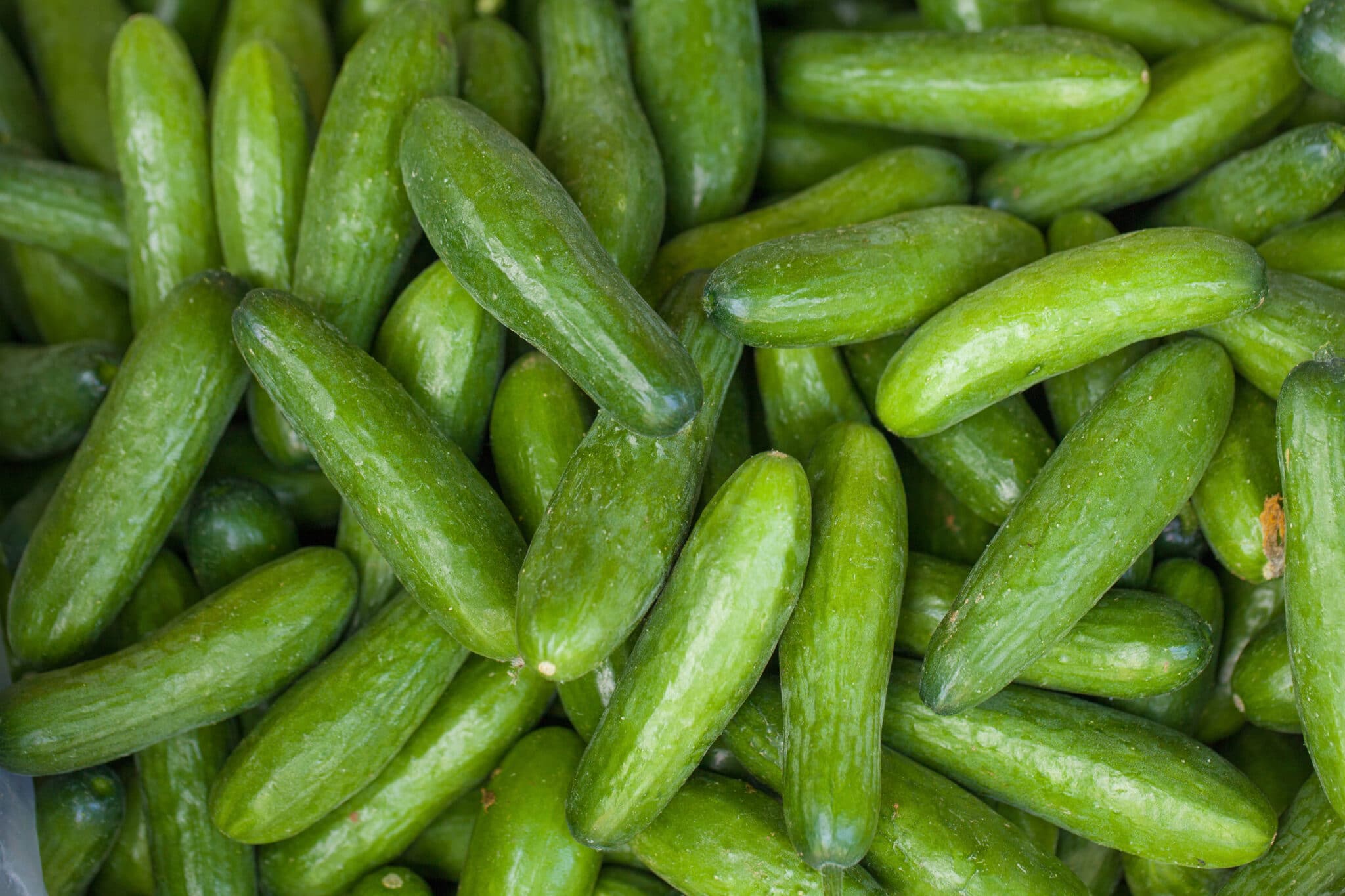

BAD BUG BEGONE!
$5.99
Are harmful insects running your gardening season?
Our guide to organic pest control methods offers practical solutions for dealing with common garden pests without using harmful chemicals. With step-by-step instructions and easy-to-follow tips, you’ll learn how to create a pest-resistant garden that is safe for your family and the environment. A great on-hand resource for any gardener!
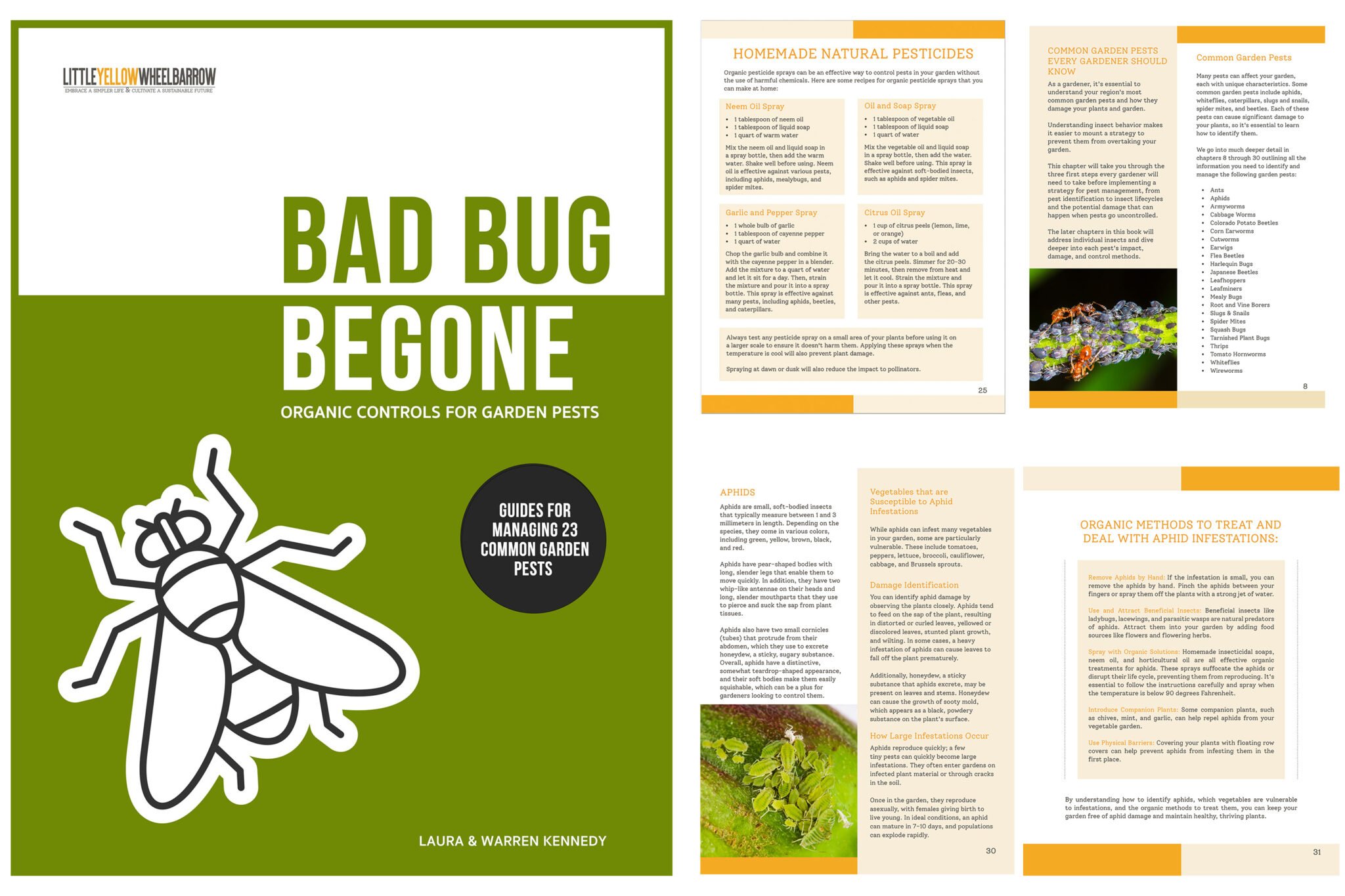
A must-have resource for Gardeners
Our digital e-book is for you if you’re a home gardener passionate about growing healthy, pesticide-free plants! Over 100 pages of organic pest management information are perfect for beginner gardeners and pros alike.
How to Grow Cucumbers
Before we can cover when or how to harvest cucumbers, we need to know how to grow them! So here’s a quick rundown of how to successfully grow cucumbers in your garden.
Sow Your Cucumber Seeds
You can use two methods for planting cucumber seeds: direct sowing or starting them indoors.
Use a sterile seed starting mix and not potting soil for best results. You will also want to avoid using garden soil for your seed starts. Garden soil can contain larvae from harmful insects that you will not want to bring indoors.
As with any vegetable, make sure you read your seed packet. It contains valuable information about your specific cucumber variety, including maturation time and expected fruit size.
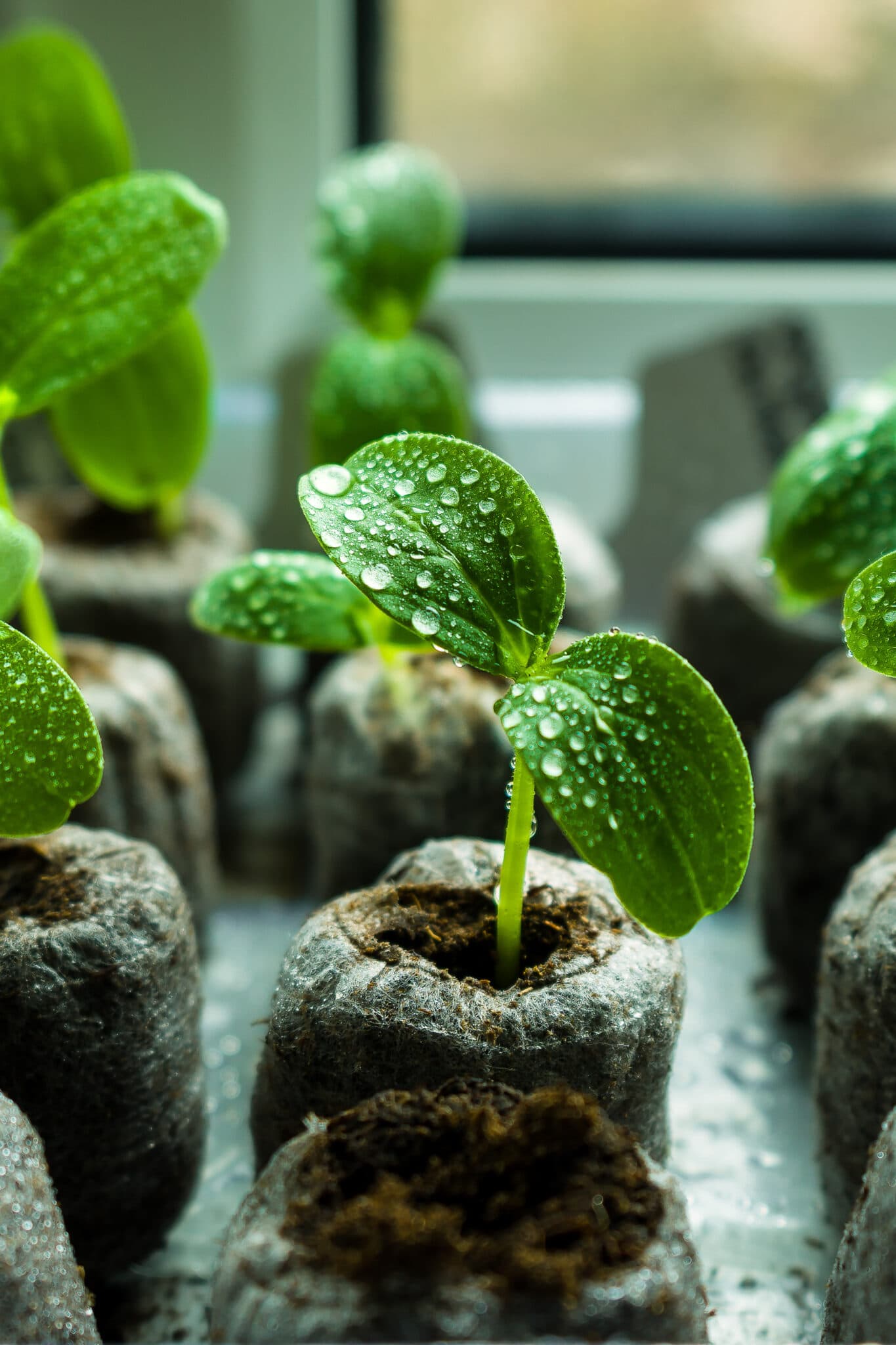
Take Care of Seedlings by Providing Adequate Light, Water, Fertilizer, and Fertile Soil
Cucumber plants started indoors will require care before they are ready to plant out. The seedlings require:
Light
Cucumber seedlings grow incredibly fast, so do not be tempted to start them earlier than required.
It’s also essential to use a grow light to start seeds indoors. No matter how bright, windowsill light will not be adequate and will develop tall leggy cucumber seedlings.
Water
Cucumbers need moist soil and consistent watering. The plants will require 1 inch of water a week during hot, dry weather. Do not let the soil dry out completely, and try to keep on top of a watering schedule.
Soil
Grow your cucumbers in well-draining fertile soil. Cucumbers thrive in soils with lots of organic matter, so work in some compost during planting.
Fertilizer
You can fertilize cucumber seedlings after the second set of leaves appears on the plant. Use 1/2 dose of general-purpose organic liquid fertilizer.

Plant Cucumber Seedlings 1-2 Weeks After Your Last Frost Date
Cucumbers need a long growing season – most varieties are ready to harvest around 50-70 days after planting the seeds. The soil temperature should be above 70F before directly sowing or planting out. Cucumbers are tender plants that can succumb quickly, even to the lightest of frosts.
It’s best to wait two weeks after the last predicted spring frost before planting cucumbers outdoors.
Not sure when to expect your last frost? Check out this tool on the Old Farmer’s Almanac to check the expected frost dates for your region.
Grow Cucumber seedlings in a location with full sun
Growing cucumbers in full sun will produce the best results. You can grow cucumbers in partial afternoon shade, but they do tend to produce more fruit in full sun.
Provide 1 inch of water per week
Your plants will need at least 1 inch of water per week, even more, when hot. Using a soaker hose to water close to the ground will reduce evaporation and prevent water from getting on the leaves, which can cause leaf diseases.
Plan a watering routine that’s consistent, because inconsistent watering causes bitter-tasting cucumbers.

Consider Using a Trellis for Vining Cucumber Plants.
If you want to use trellises to train your cucumber vines to grow vertically, set them up before your plants need them, so you avoid damaging your seedlings or vines.
To grow cucumbers on a trellis, you will need fastening tape to keep the cucumbers fastened. We like to use velcro tape for this purpose. It holds up, but you can make it loose to enable the plant to move and grow as required.
Consider Adding Companion Plants to Help with Pollination and Pest Control.
Plant some companion plants around your cucumbers like sunflowers, marigolds, beans, etc.
Companion plants can help encourage pollinators and beneficial insects to the garden. They can also help deter harmful insects away from your cucumbers.
- Learn More: Cucumber Companion Plants List
- We also have specific guides on using marigolds and nasturtiums as companions around the vegetable garden, and a full guide to managing the pesky squash bug.

If You Lack Pollinators, You Can Try Hand Pollinating Your Cucumbers
Cucumber pollination can be time-consuming when done by hand, but it may be the only way to ensure a large harvest of mature fruit if your garden lacks pollinators. If you are growing your cucumbers in a garden that lacks pollinators, consider growing a few flowers and herbs to attract bees and pollinators to your garden.
The key to hand pollination is to differentiate male flowers from female flowers.
The male flowers will have a long stamen in the center of the flower that is dusted with pollen. The male flowers will also bloom in clusters of 5-6 on one stem.
The female flower will have a small fruit at the base of her stem and bloom alone, singly on a stem. The female flowers also contain a small ovary in the center.
You can start hand-pollinating as soon as the first female flowers have opened. When hand-pollinating cucumbers, only use freshly opened male flowers. Remove the pollen with a small brush or q-tip, and gently roll the pollen onto the stigma in the center of the female flower.
You can use the same male flower to pollinate several female flowers.
Harvest Cucumbers Often
When your cukes are ready to harvest, you’ll likely have some to pick almost every day, so check your vines frequently. Use these helpful tips to make sure you get the best harvest possible.
Check Plants Daily
Checking your plants every day is the key to having healthy plants and bountiful yields.
Keep a close eye on your plants and be on the lookout for:
- Stunted (not growing) cukes, or fruits with rotten ends
- Cucumbers that are past their prime
- Powdery mildew – occurs when leaves get wet (you will need to apply a fungicide to remove it)
- Watch for aphids, cucumber beetles, or other pests. Consider companion planting flowers such as nasturtiums or marigolds. Marigolds, for instance, will help deter cucumber beetles, and nasturtiums can confuse and deter aphids.
Pick and discard any stunted, rotten, or overripe cucumbers to help the plants dedicate their energy toward maturing fruit you’ll harvest.

Know When to Pick Your Cucumbers
Every variety of cucumber is going to have a different maturing time and expected size. When to harvest cucumbers depends on the types of cucumbers you’ve planted. Check the seed packet to find out how big your ripe fruit will get, so you have an idea what to look for out in the garden.
Harvest cucumbers when they reach the target size for your particular variety, and have dark green skins. Cucumbers ripen about 50 to 70 days after planting, depending on the types of cucumbers you planted. Be sure to pick the ripe fruits as soon as your cucumbers are ready, before they start to turn yellow, or they will have a bitter flavor.
Harvest Frequently
Fun fact: the more cukes you pick, the more your plant will produce! The reverse is also true – if you don’t harvest your cucumbers, your plants will produce less.
I recommend checking your plants and harvesting ripe cucumbers in the morning before the vines get hot.
You’ll likely be picking multiple cucumbers almost every day during the peak season. Continue to check your plants daily, even during the off-peak season, to make sure you harvest before they get overripe.
When harvesting cucumbers for pickles, harvest when the cucumbers are 2 inches long for making sweet pickles and about 3-4 inches long for making dill pickles.

Tips to Properly Harvest Cucumbers
Instead of pulling or twisting ripe cucumbers off the vine (this may damage your plants), use pruners, garden shears, or a sharp knife and cut the stem leaving about ½” of the stem still attached to the fruit. This method helps keep the end of the cucumber from rotting in case you don’t use it immediately.
Burpless and English cucumber varieties tend to bruise thanks easily to their thinner skins. When you harvest them, gently place them in your basket or container.
You may be surprised to learn that most cucumbers can be prickly! Wear gloves when you harvest, and rub a soft cloth or vegetable brush on your cukes to remove the spines.
Pinch off the remaining flowers on your vines about 30 days before your expected first frost so that your plants can focus their energy on ripening the cucumbers that are currently growing.
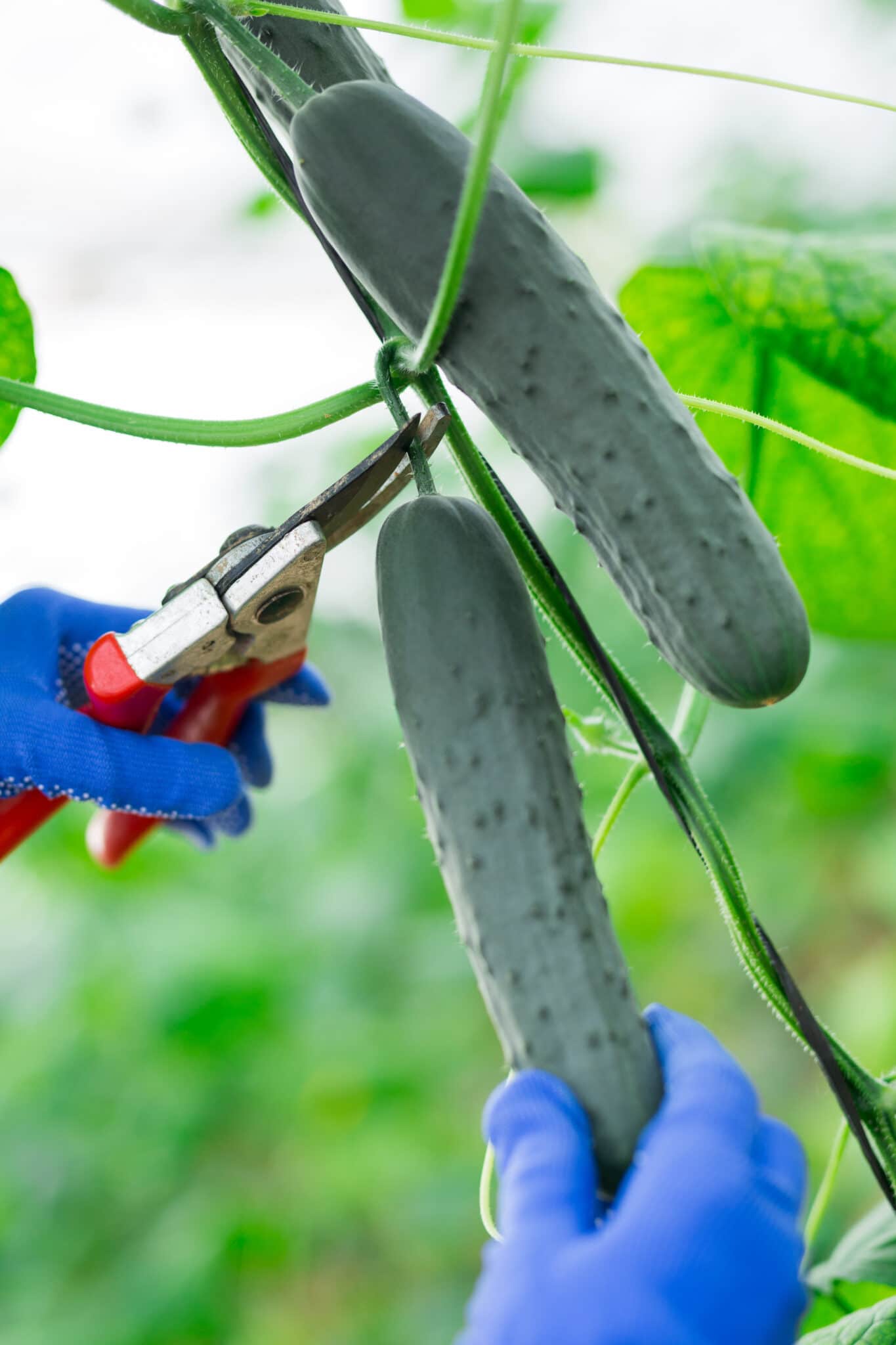
Prepare Harvested Cucumbers For Long Term Storage
Once you harvest the cucumbers for the season, it’s time to enjoy them!
Your cucumbers won’t continue to ripen after you pick them, unlike many other vegetables and fruits.
Store your pickling cucumbers in a cool dark place for up to 5 days before making pickles.
Slicing cucumbers can be stored in the crisper bin of your fridge for up to 7 days, but are best eaten fresh!
Growing Cucumbers From Seed to Harvest
Growing a cucumber plant is an easy adventure so long as you provide them with the items we listed above.
Now that you know how to grow, care for, and when to pick cucumbers, it’s time to put them to good use! If you planted cucumber plants this year and you have a bumper crop and you’re wondering what to do with all these cucumbers we have help for you!
You can start by making these wonderful garlic pickles (we make 4 dozen quarts every single year and eat every single one of them). Or you could check out this list we put together for dealing with excess cucumbers!
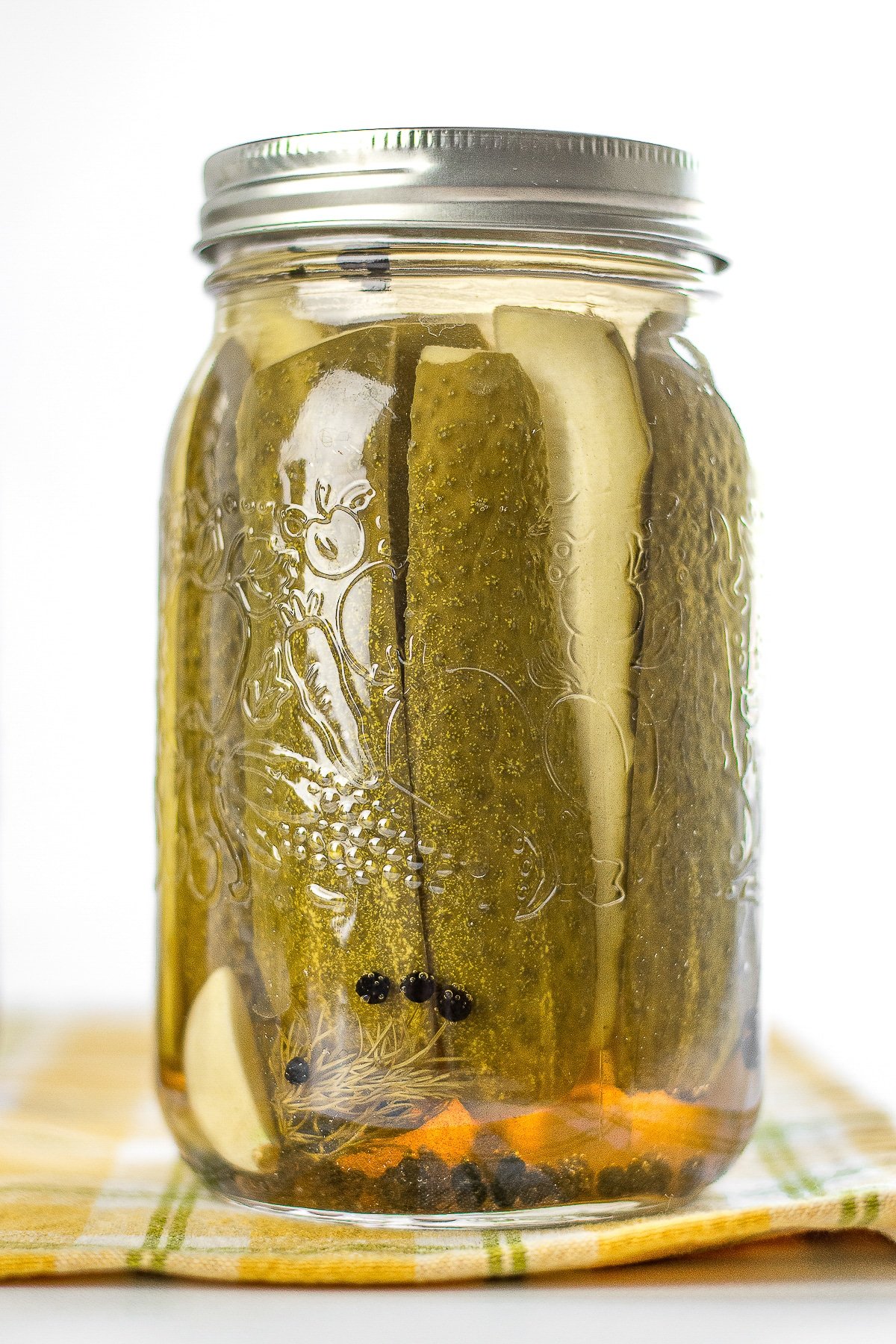
More Garden Inspiration:
Editorial Note: This post was originally published on February 3, 2021, and was updated on January 16, 2023.

Author: Laura Kennedy
Writer & Owner of Little Yellow Wheelbarrow
Laura is a highly skilled gardener and fervent flower enthusiast. Despite her playful battle with plant spacing guidelines, Laura’s work inspires gardeners to create thriving, beautiful spaces that reflect both creativity and sustainability.












